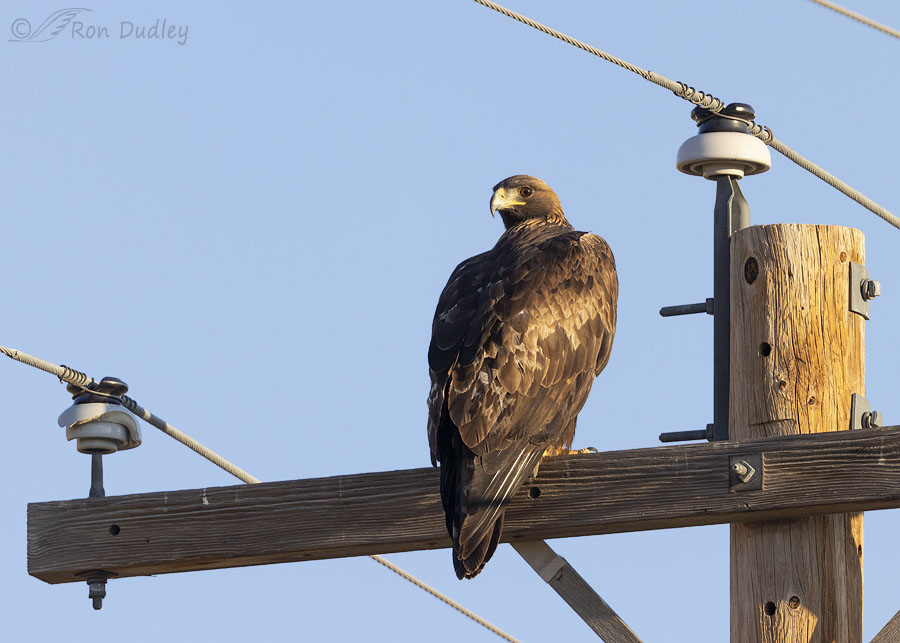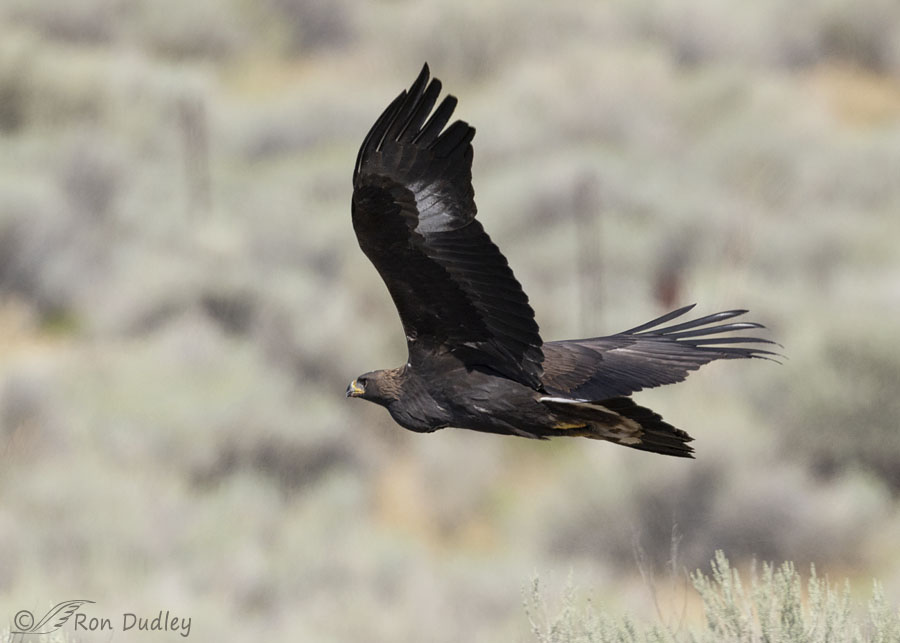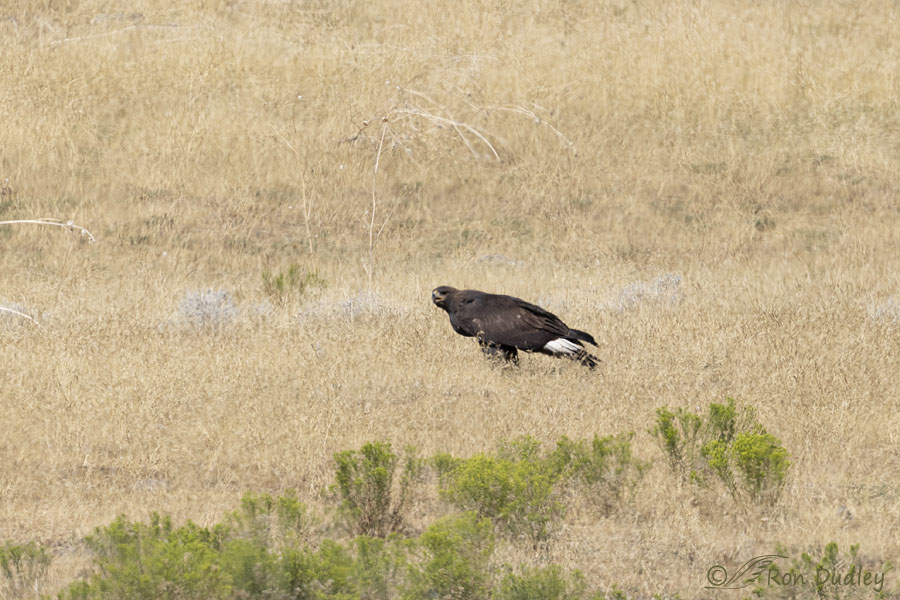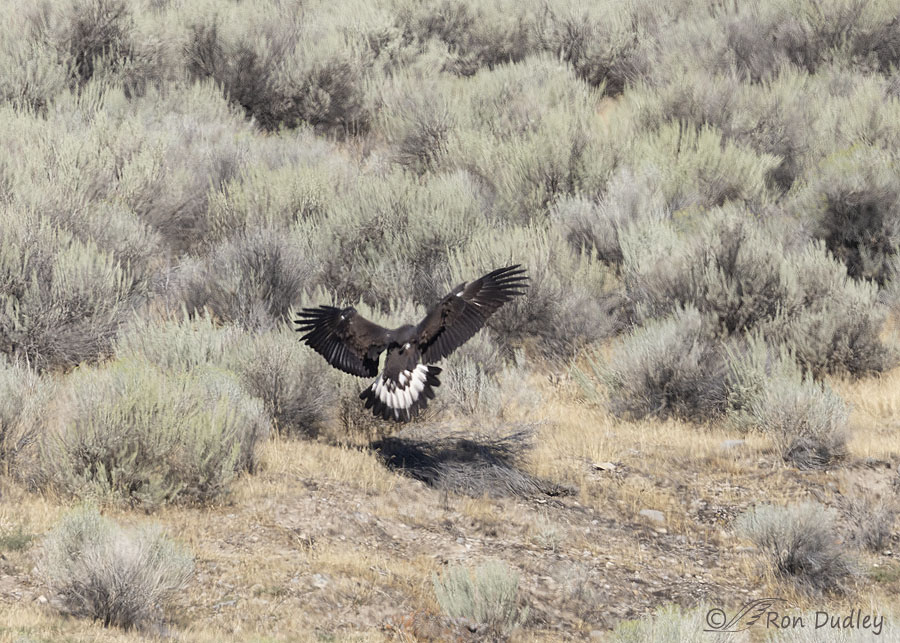These days encouraging news about Golden Eagles is hard to come by.
In recent years Utah’s west desert Golden Eagle populations have been in serious decline. The reduced numbers are significant enough that HawkWatch International is running multiple field research projects to better understand Golden Eagle populations and the reasons for their decline. Our Golden Eagles feed largely on Lagomorphs (hares, pikas and rabbits) and early results strongly suggest that the recent decline of jackrabbits due to Rabbit Hemorrhagic Disease (a lethal form of viral hepatitis) is likely a factor in record low reproductive success for Golden Eagles.
My own observations in the field also suggest that Utah’s Golden Eagles are in trouble. In my frequent birding trips to remote areas of northern and western Utah I used to see Golden Eagles often, sometimes as many as a half dozen or more in a single morning, but I rarely see them anymore. In most of my recent trips to those areas I haven’t seen a single one.
So yesterday morning I was highly encouraged by an encounter I had with two juvenile Golden Eagles in prime habitat for the species. I didn’t get any great photos of them, but sometimes quality photos aren’t necessary to buoy my spirits in the field and for long after I arrive back home.

Soon after sunrise I found this side lit Golden Eagle on a power pole next to the deserted road. In past years I rarely stopped for Golden Eagles on utility poles because those types of photos do little for me. But these days a Golden Eagle encounter is so unusual I stopped to take a few documentary photos and then went on my way to my destination. The eagle was still on the pole when I left.

Then, on my return trip 2 1/2 hours later, two juvenile Golden Eagles took off from clumps of sagebrush within a couple of hundred yards of where I’d found the eagle on the power pole earlier that morning. One of them, this one, circled low over the sagebrush twice before they both landed in separate areas on the hillside to the west about a quarter mile away. This is the best photo I managed to get of the eagle that was circling low.
So, why was I so encouraged by this encounter? There are three reasons:
- The first reason should be obvious. After seeing so few Golden Eagles for the last few years, any sighting of the species is good news.
- These eagles were young juveniles and they were hanging tightly together so they’re almost certainly siblings from the same nest. Two successful fledges from the same nest is a highly positive development.
- Both birds were stuffed to the gills – just look at the engorged crop of this one. I don’t know what they’d been feeding on, even though I looked hard for evidence of nearby prey or roadkill. Good Samaritans sometimes drag roadkill off the road to prevent scavengers from becoming additional victims, but I found nothing. But it would have been easy for me to miss a rabbit or a deer carcass or anything else hidden amongst the sagebrush.

Here’s where one of the young eagles landed on the hillside about a quarter mile away. Even at this distance, and through all the heat waves that made my photos soft, we can clearly see the engorged crop of this bird.

When the other young eagle landed far away on the same hillside, the prominent and extensive white at the base of the tail of juvenile Golden Eagles was clearly revealed.
I know, Golden Eagle sightings from a single morning in the same area are far from strong evidence of a recovery. But it’s an encouraging sign and I’ll take it.
Ron


“I didn’t get any great photos of them…”. I’d say pretty much any photo of Golden’s are great photos. The shoulder girth of the one in the first photo is impressive.
I watched the video by Dustin Maloney of HWI embedded in the link you provided. Amazing and intrepid work he’s doing hiking and repelling to the nests. As you might expect, major causes of population decline are “anthropogenically caused- collisions, poisoning, and as your first photo suggests, electrocutions.
Lyle, Dustin isn’t the only one at HWI who puts life and limb at risk doing nest studies of Golden Eagles and other raptors. They’re a dedicated bunch.
You had me at Goldens! The first thing I thought when I scrolled to the flight shot was, “Wow! Look at that crop!” Beyond delighted that these juveniles graced your lens and that they look so healthy and well-fed. I hope it’s a sign for better things to come for one of my 3 favorite bird species.
The first thing I thought when I scrolled to the flight shot was, “Wow! Look at that crop!” Beyond delighted that these juveniles graced your lens and that they look so healthy and well-fed. I hope it’s a sign for better things to come for one of my 3 favorite bird species.
It’s pretty hard to miss that crop, isn’t it Mart. Thanks.
EXCELLENT news. I understand completely why you were so encouraged. Juveniles are a positive sign and stuffed to the gills juveniles are even better.
EC, I sure wish I could have found what they’d been eating!
OK, perhaps not frame-worthy photos (though I’m a sucker for over-the-shoulder “glamour” shots) but these Goldens are still sights to behold, especially given their apparent declining numbers. So happy for you that you found them and happy for them that they found big meals somewhere! I hope you and they have more such fortunate encounters in the weeks ahead.
“I hope you and they have more such fortunate encounters in the weeks ahead.”
Chris, I REALLY wanted to go back to that area again this morning. If they’re feeding on a deer carcass there’s a good chance they’re still hanging around, but another pressing issue prevented me from going.
Grateful for your ‘work’, documenting sightings of these birds is uplifting to me, inspiring, and beautiful.
And sometimes reminds me of forgotten memories. On a drive through my area I came to a sudden stop when I saw a pair of golden eagles on a hillside rock cropping. Back lit and shadowed by the rocks my pics were just good enough to id the birds, but inspired me to by a quality zoom lens. I just sat and watched them for 30 minutes. They are known by quite a few folks in the area, the Geysers area of Lake County CA, if anyone is interested.
” my pics were just good enough to id the birds, but inspired me to by a quality zoom lens”
JK, it’s interesting how Golden Eagles can inspire us in so many ways, some of them pretty hard on the bank account.
Of my many ‘inspired’, often foolish, purchases my lens remains the most cherished, can’t wait to be able to use again. Aging body not very cooperative these days, but you can relate to that.
Yay! You found them. Is this the same area were we ran into each other? If so, I wondered if one of the two I saw on the stack of rocks was a juvenile. I would of had a decent shot, though back lit, if the sheriff had not stopped to inquire how I was doing. I am seeing more rabbits and hares this year. Hope to see more eagles again too.
April, these photos were taken about 14 miles north of where you and I ran into each other.
Ron, thank you for sharing the shots and information. I have not been out much this summer to check on the wildlife in my area. It was nice to see you found a couple of Golden Eagle.
You’re very welcome, Trudy.
That certainly is a encouraging sign Ron. No photographers like a bird on a pole, but I definitely would make an exception for a Golden Eagle or even a Bald Eagle. Forgetting the pole, that first one is a good photo. I wonder how long a bird species will stay in an area where it is not being fed before make the decision to move on? Sure hope for you and others in that particular area that enough game is available to keep those young eagles there.
Very interesting post. Sorry to say that I have never seen a Golden in the wild.
Everett, there seems to have been plenty of prey in that area this summer, for all manner of raptor species.
Great series Ron!
Charlotte Norton
Thanks, Charlotte.
Wonderful photos of these beautiful juvie Golden Eagles! I can’t imagine that their crops would be that full one rabbit so I go with your guess of deer roadkill. They clearly are successful hunters or scavengers. And congrats to you for finding them. The white tail feather display is quite impressive and reminds me of the feathers in an Native American Chief’s headdress. May the Golden Eagles of Utah and their prey continue to recover.
“May the Golden Eagles of Utah and their prey continue to recover.”
Hear, hear!
Hi, Ron!
Two encounters I have had with Goldens in California:
My first encounter was seeing a bird on a prey fawn in the central coastal valley west of Los Robles. The prey’s mother was in the background.
The second was watching one in the same setting as your shot on the powerline crosstree as it was eyeing a human toddler below the pole. I don’t know if there was any danger there, but I was glad I wasn’t the worried parent! (The parent might not have been aware of what was looming above.)
The second was reminiscent of the first, to be sure.
George, your comment made me wonder if there’s any reliable record of Golden Eagles, or any eagle species for that matter, attacking and killing humans. I found this, for what it’s worth:
https://www.treehugger.com/birds-that-could-steal-your-toddler-4864271
Good news indeed
Yup.
YES! Great to know some are “making it” and stuffed crops are even better news. Well worth the shots of them.
Well worth the shots of them.
Thank you, Judy.
Great shots. My favorite bird. Don’t see as many here in Northern CA as we used to. Wind farms seem to be the main problem. The units are too close together. The valley between Sacramento and the Coastal Mountains is, or used to be, the major breeding area for these birds in the country.
Sallie, the effect of wind farms on eagles of both species is distressing.
Great shots and great lesson Ron! Thanks for sharing.
Thanks, Jerry.
Very encouraging. Thank you for sharing this bit of positive. It’s something we do not hear much of as of late.
Whatever it was they got a hold of, they sure look like they got their fill.
Michael, their crops were so engorged it was a wonder they could still fly.
WOW!! Great shots of an iconic symbol, at least to me, of the American West.
Many thanks for the encouraging words that maybe the Golden Eagle are recovering.
Thanks, Dick. I think they’re an iconic symbol for all of us. They certainly are for me.